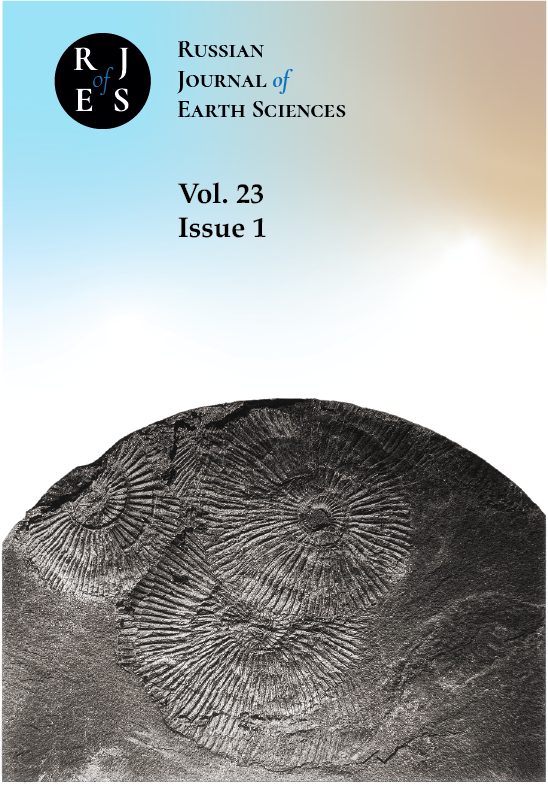from 01.01.1993 until now
Russian Federation
from 01.01.2009 until now
Russian Federation
UDC 551.465.755
CSCSTI 37.01
CSCSTI 37.15
CSCSTI 37.25
CSCSTI 37.31
CSCSTI 38.01
The level fluctuations of the White Sea (WS) in the synoptic range of time scales including tides and surge fluctuations are considered based on observational data covering the period 2004–2020. The hourly level observation data of the coast stations were used: Sosnovets, Severodvinsk, Solovki, Kem-Port, Kandalaksha, as well as in the area of the White Sea Biological Station of Lomonosov Moscow State University (WSBS MSU) in 2008–2009. The values of spring and neap tides at these points are refined, and their features such as parallax inequality and the influence of shallow water components are considered. The surge run-offs and run-ups are explored based on the analysis of residual sea level fluctuations (RSL), which is determined by removing the tidal component from the observational data. The RSL fluctuations in the Dvina Bay are characterized by the greatest variance. The RSL fluctuations at Solovki and Sosnovets have approximately the same variance, which is significantly lower than in the Dvina Bay. The lowest variance is observed at Kandalaksha. According to the data obtained at the Severodvinsk and Solovki stations, a noticeable increase in RSL variance is observed, which indicates that the intensity of RSL fluctuations increased during the time interval under consideration. This conclusion is also confirmed by the calculations of the positive RSL values survivor function, as well as by the fact that the number of surge run-ups with a height of no less than 100 cm for 11 years (from 2004 to 2014) was only two, and in the six-year period (2015–2020) there were already five such events. The largest surge run-ups at Severodvinsk during the period under review reached a height of 130 cm (August 22, 2018) and 153 cm (November 15, 2011). Significant surge run-offs occur less frequently than surge run-ups and, as a rule, are inferior to the latter in their absolute value. The surge run-off on January 31, 2005 was the strongest for the entire period of 2004–2020. At Severodvinsk RSL decreased by 123 cm below the average monthly mark. In other cases, the most significant RSL falls relative to the average monthly value were about 70 cm.
Tides, residual sea level (RSL), storm surge fluctuations, variance, survivor function, synoptic situations, surge run-up and surge run-off characteristics, interannual variability
1. Filatov, N., D. Pozdnyakov, and O. M. Johannessen (2005), White Sea. Its Marine Environment and Ecosystem Dynamics Influenced by Global Change, 462 pp., Springer Berlin Heidelberg, Berlin, doihttps://doi.org/10.1007/3-540-27695-5.
2. Horsburgh, K. J., and C. Wilson (2007), Tide-surge interaction and its role in the distribution of surge residuals in the North Sea, Journal of Geophysical Research: Oceans, 112(C8), C08,003, doi:https://doi.org/10.1029/2006JC004033.
3. Inzhebeikin, Y. I. (2003), Fluctuations in the level of the White Sea, 152 pp., Russian Academy of Sciences, Ural Branch, Institute of Ecological Problems of the North, Yekaterinburg, (in Russian).
4. Kondrin, A. (2012), Non-tidal fluctuations in sea level in the area of the White Sea Biological Station of Moscow State University, Moscow University Bulletin. Series, (3), 80-85, (in Russian).
5. Kondrin, A. (2016), Storm surge formation in the White Sea, Moscow University Bulletin. Series, (6), 33-40, (in Russian).
6. Kondrin, A., and A. Pantyulin (2010), Tidal level fluctuations in the estuarine system Velikaya Salma - Rugozerskaya Bay of the White Sea, Moscow University Bulletin. Series, (6), 67-72, (in Russian).
7. Kondrin, A., A. Korablina, and V. Arkhipkin (2018), Results of numerical modeling of storm surges in the White Sea, Moscow University Bulletin, (2), 33-40, (in Russian).
8. Korablina, A. D., A. T. Kondrin, and V. S. Arkhipkin (2017), Numerical simulations and statistics of surges in the White and Barents seas, Russian Journal of Earth Sciences, 17(4), ES4004, doihttps://doi.org/10.2205/2017es000608. EDN: https://elibrary.ru/ZXVGGN
9. Kulikov, M. E., I. P. Medvedev, and A. T. Kondrin (2018), Seasonal variability of tides in the Arctic Seas, Russian Journal of Earth Sciences, 18(5), ES5003, doihttps://doi.org/10.2205/2018es000633. EDN: https://elibrary.ru/VMBNZC
10. Monin, A. S. (1982), Introduction to the theory of climate, 247 pp., Gidrometeoizdat, L., (in Russian).
11. Pawlowicz, R., B. Beardsley, and S. Lentz (2002), Classical tidal harmonic analysis including error estimates in MATLAB using T_TIDE, Computers and Geoscie, 28, 929-937.
12. Terziev, F. S., G. V. Girdyuk, G. G. Zykova, and S. L. Dzhenyuk (Eds.) (1991), Hydrometeorology and hydrochemistry of the seas of the USSR, vol. 2, 240 pp., Gidrometeoizdat, L., (in Russian).
13. Emery, W. J., and R. E. Thomson (2001), Data Analysis Methods in Physical Oceanography, 638 pp., Elsevier Science, Amsterdam, doihttps://doi.org/10.1016/B978-044450756-3/50014-9.

















